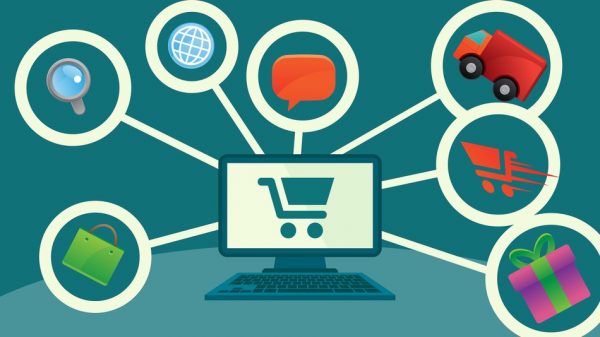
Connected consumers are using more screens more of the time. Flipping between the computer, smartphone, tablet and ultimately the store is the reality of today’s shopper journey. This year, these lines will continue to blur and it will be more important than ever for brands and retailers to embrace adaptive strategies for ecommerce. It is not just the simplicity of where and how consumers purchase items that will satisfy consumers, but things like price, speed, delivery cost & locations, product quality, inventory availability are becoming top priority for customer retention.
Mobile Commerce
A few years ago, mobile commerce was considered an extra or add-on but today, it is the new way of life. So it would not make sense to limit the purchase process to one particular channel. Mobile payments are not a new thing in the commerce world. Google, Square and Amazon have been implementing it for years however new technologies are changing the way mobile is used much less the channels it can be used in. Mobile payments will continue to increase in the future so mobile-centric strategies should continue to be top of mind for retailers and brands this year:
- Simple, secure payment options (POS or on-line is a definite must have). Apple Pay raised the stakes for mobile payments, and the 2014 holiday season definitely exhibited that. Consumers are asking a simple solution to ease their minds and provide a simple, secure payment option. And retailers caught not being able to accept new adopted payment types may see their competitors win their consumers.
- Hybrid shopping – integration of channels (mobile commerce, online, social, brick-and-mortar). All of these channels have become the norm so more ecommerce merchants are enhancing their sites for mobile and implementing bricks meets clicks and mobile payment options to increase their sales.
- Optimization of mobile web – Retailers and brands will increase market share by improving the mobile web experience (customization, personalization, faster load times, easy to use, etc.).
Social Commerce
With social channels ever increasing, consumer engagement is key now more than ever. Social product discovery and effective targeting are also helping the bridge the gap between mobile devices and online stores. A recent study [1]showed that while organic and paid search are still in the lead, social media purchases have increased over 202% in the last year alone. It is clearly becoming an effective channel to bring in sales. Social commerce sales are predicted to grow by 93% per year in the United States which means if retailers and brands want to stay relevant, they will need to “socialize” more in order to stand out from their competitors. So along with implementation of omni-channel and effective mobile strategies, retailers and brands need to use social selling to customize product offerings:
- Real-time Deals & sales – Cartwheel is a great example that unites social channels with in-store offerings and sales real-time. Social sites such as Facebook lead a consumer to his or her product preference why they are actually in the physical store. Other companies are trying to follow suit this year and will pave the way for other ecommerce retailers to help set the standard for obtaining more social commerce market share.
- Interactive & Responsive content – Brands and retailers can utilize web design that is responsive and functional to differentiate themselves. They can create functionalized views based on social activity as much as data collection and respond with personalized content rather than corporate content.
- Big Data & Analytics – Leading brands and retailers will use big data a bit broader in order to understand the consumer and customize content for offerings and messaging. Instead of analyzing siloed consumer data from marketing research, they can leverage Facebook “likes”, Pinterest activity and previous purchase history to market to consumers in “niche” product areas.
The Future is Digital
Becoming digital is the surest way for you to understand your customers' needs and meet their expectations. Learn how Perficient can help anticipate what's ahead for you and your customer with a digital strategy centered around empathy, alignment, and agility.
Wearable Technology
Wearables have certainly made a name for themselves over the past year, especially with the launch of the Apple Watch. But what exactly does this mean for ecommerce? For one, it will definitely give consumers easier access, similar to your smartphone but actually attached to your wrist. These technologies put the internet at even a closer and convenient reach, making it even more a part of our daily if not hourly lives. With the Apple Watch, consumers are able to double tap the side button to bring up form of payment when they want to purchase a product or service. They then will be able to hold up the watch to a NFC reader to complete the transaction. Apple claims that this will reduce the overall time (by 5 or 6 seconds) it takes to make a purchase compared to utilizing your smartphone or actual credit/debit card. It remains to be seen how wearables will win out against the smartphone or other devices but for retailers and brands it will come down to the ease of the transaction and the collection and use of data. Wearables have the capability of influencing the ecommerce market in 2015 by:
- Bridging a gap – Wearables could possibly help bridge the gap between digital and brick-and-mortar by providing another channel that can be accessed more quickly and easily leading to happier and more satisfied consumers.
- Increase in speed – Wearables could provide faster updates on promotions, price changes, offerings and marketing incentives to consumers more often.
- Geo-location – Wearables allow location-based deals to tie marketing information to the consumer’s real-time location (i.e. Starbucks).
Shipping, Inventory, & Same Day Service
As consumers, we know how demanding we can be and the increasing want for convenience and immediate results. This has been the one advantage that brick-and-mortar has had over the digital world, immediate fulfillment – I buy it now and take it with me. BUT now due to online retailers upping their game with cheaper (sometimes even free), easier and faster shipping, consumers can get that immediate satisfaction they get when purchasing in the store. Brick-and-mortar stores are also improving the in-store experience enabling consumers to search online and use the store as their own fulfillment center. What it comes down to is who is the fastest, cheapest and most convenient for the consumer.
- Shipping – Online ecommerce sites started offering free overnight delivery and returns and so began the delivery revolution. That window time has decreased even further to some companies moving to 30 min and same day delivery options. Amazon Local and Google Shopping Express with the help of brick-and-mortar are allowing ecommerce to become more flexible and provide free & immediate shipping as well as helping to bridge the gap between digital and the physical store. Taking it a step further, evolving companies like Uber and Lyft have the capability (with their local transportation network) to enable same day and courier delivery.
- Inventory – One of the things that consumers want to know and have visibility to if their product is available to purchase and ship and not delayed due to “out of stock”. So ecommerce companies need to make sure their inventory is accurate and visible to the consumer.
- Fulfillment – Same day service is still a work in progress as it has tried and not succeeded in many markets but store pick-up and next day delivery are going to be very strong in 2015. Companies like Amazon are building or buying warehouse to keep pace with the rapidly changing consumer demand. Smaller companies are also turning to giants like Amazon to outsource fulfillment so that delivery turnaround is faster.
All in all, 2015 will be all about adaptation and transformation for the consumer markets industry. At the end of the day, retailers and brands need to be flexible enough to adapt to the empowered connected consumer and be proactively predicting what trends will stick and ones that will not. Leading companies will gain market share when they are listening to their consumers who are telling them where they need to be. To truly transform and create real opportunities, companies will need to understand their consumers and their demand, have flexibility in end-to-end logistics and have the ability to shift from B2B to B2C or vice versa.
[1] Source: www.shopify.com/blog /212731545-which-social-media-platforms-drive-the-most-sales-infographic
